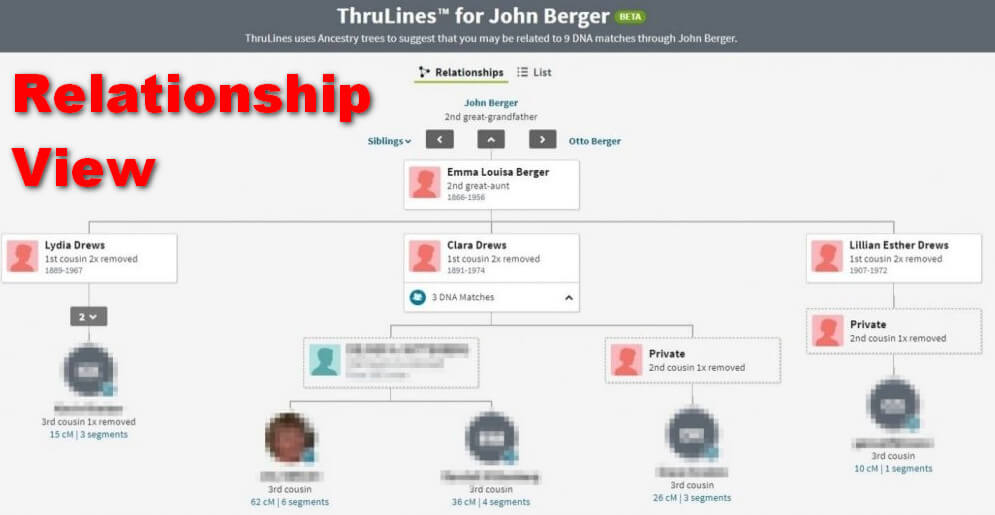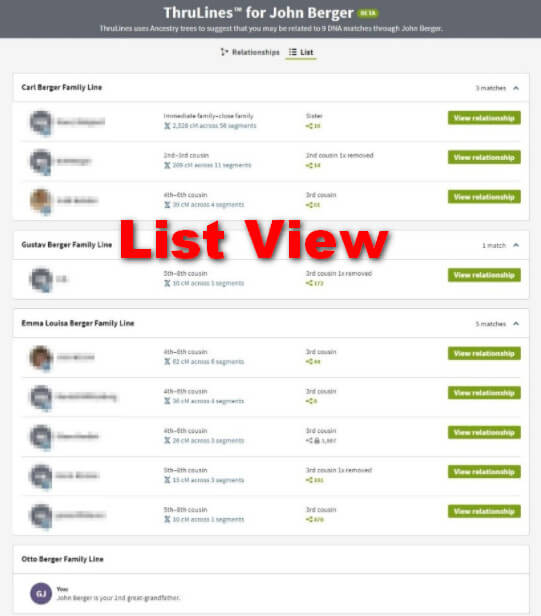Are you interested in expanding your family tree? Consider employing Ancestry ThruLines, a recommended tool by genealogy researchers. This tool allows you to identify DNA-tested relatives and matches, significantly aiding in the growth of your family tree. With a simple click of a button, it uncovers matches that would otherwise take a considerable amount of time to discover, streamlining your genealogical research.
What is Ancestry ThruLines?
- Ancestry ThruLines is a tool that identifies DNA-tested relatives and matches based on the data in family trees.
- Its accuracy depends on the correctness of the data in family trees; errors can result in misleading ThruLines.
- ThruLines can be viewed by the user and invited DNA results viewers. However, if a tree is private or unsearchable, ThruLines and match results will be unavailable.
Are Ancestry Thrulines Accurate?
It is essential to note that Ancestry ThruLines’ accuracy relies on the correctness of the data in family trees. Inaccuracies can lead to incorrect connections and misleading results. Therefore, it is advised to verify suggested matches from ThruLines.
How To Explore Ancestry Thrulines
John Berger & Eva Lenz were great-great-grand parents of my family. One of my researcher has discovered a unique information deal regarding Eva’s parents and the increased family, but I didn’t spent a high time to research about John. He is from Mecklenburg, Germany to Minnesota as adult. And it is not known to anyone that any of his siblings or related family who came together with him. John buried in the cemetery at Lutheran church from where the family has generation history. Personally, I have not verified the burial registers of church, but a distant relative from the family has reported the names of John’s parents listed there.
Many descendants of Eva & John are in my Ancestry DNA matches list on various authorized testing websites. I make use of shared matches’ features to find out other DNA matches who shares DNA with me or with any descendants of Lenz/Berger.
Ancestry Relationship View
Ancestry ThruLines has two kinds of views i.e. Relationships and List. Relationship view offers a graphical view of descendant’s available ancestors.
The default view of John Berger displays your connection to him although it is possible that some details may be collapsed, and other DNA testers who are the only descendants of a child of that particular ancestor. DNA data may collapsed for all children of that targeted ancestors but can only be expanded by pressing on the “#DNA matches” link under the name of child.
To review the detailed information for a specific line, press on “5 DNA matches” available below their name, which may result in the below given view.

This will offer the information of ancestral path to each of the DNA matches from the particular family, their relationship, and the DNA amount shared with them.
Default relationship view of John displays about the descendants of John’s children has tested. John and Eva had total of six childs. Four of them are listed here (Carl, Gustav, Emma, and Otto) with a daughter Bertha and a son Henry. The son henry died in age around 20 years and had no children. I had done a research on my DNA results to find out Bertha’s descendants in case those are detectable by Ancestry ThruLines.

Bertha’s family is big and most of her children had children. The lack of tested descendants shows a research opportunity for ThruLines. Bertha likely to inherited some of the elements of John’s DNA that her sibling may not have so it may be a beneficial research for this family if her descendants also available in the testing databases. In the earlier research, I found only 14 of Bertha’s grandchildren who born between 1912 & 1938. If we focus on the younger grandchildren it may be a best technique to search for available testers. If no grandchildren are available, then recruiting the great-grandchildren is also a better option.
Ancestry DNA List View
The List view also displays the descendants list similar to the relationship view but all those are in a single list. While using Relationship view, if you expand a single line then other lines may automatically contract. Whereas, List view offers “a glance view” with all the DNA relationships and included shared DNA matches information.

Seeing the Ancestry DNA relationships data and amount of centimorgans shared with ancestors for all the relatives at a single place offers a great benefits to cross-check for your ancestry family tree and also for family trees of your DNA matches. If the predicted DNA relationships and centimorgans are not found consistent with each other, then it is possible to have errors in your family tree or the other people trees that you have used to collect DNA data. This type of descendants view can sometimes make only half relationships more apparently then they actually are by viewing the individual DNA results.
How to Get Ancestry DNA ThruLines
To get the thrulines you need to follow its procedure step by step and then wait for the outputs:
- Firstly you need to take the Ancestry DNA test.
- Opt for the features to see & be seen to DNA test.
- Link the Ancestry family tree to the DNA test.
- Ensure that the tree you have linked is either public or if private it is searchable.
- Develop the linked family tree back for at least four generations.
- Check the results after two days; if Ancestry ThruLines are available, the outcomes will be shown within next 48 hours.
Exploring Ancestry DNA ThruLines
- Navigate to any page of your Ancestry account, and then press on the DNA tab and choose ThruLines.
- On the Ancestry ThruLines page. Choose an ancestor from the available list to view which DNA matches may relates to you through that person.
- Number of Ancestry DNA matches those are related to you through this ancestor will be listed on the top of same page. There you can also switch between Relationships & List.
- When you select Relationships, the ancestor you have choosen will be shown at the top of page. All the ancestors having DNA symbol by their displayed name is one of your DNA ancestry matches. People those are displayed as “Private” are either living or they belongs from private but searchable family trees.
DNA Ancestors from the linked family tree will display at the top of Ancestry ThruLines. When you scroll down the page, you will see the people with dotted lines around their name. These people are known as potential ancestors- People those are not available in your family tree but they are listed in other people’s family trees. To see the people only those are available in your tree you can make use of filters option. You can tap on filter to see the list of people who are in your family tree or only those are potential ancestors.
How Often Does Ancestry Thrulines Update
Ancestry ThruLines updates regularly as new information becomes available, such as new DNA matches, changes in family trees, or the addition of new information to existing trees. While there is no fixed schedule for updates, you may see changes in your ThruLines as Ancestry continues to process new data and refine their algorithms. It is a good idea to check your ThruLines periodically to stay informed about any updates or new connections.
How To Fix Ancestry Thrulines Not Working
If Ancestry ThruLines isn’t working, ensure your family tree is linked to your DNA test and goes back four generations. Check if your tree is public or searchable, and allow time for updates to take effect. Clear your browser cache or try a different browser. If issues persist, contact Ancestry Support for assistance. ThruLines is an evolving feature, so check back periodically for updates and new connections.
What Happened to Thrulines on Ancestry
Ancestry ThruLines is an active feature on Ancestry.com, and it was rolled out to everyone during March. If you previously had ThruLines but now face issues like the Circles placard returning or encountering non-functional pages, it could be due to a temporary technical issue or changes to your linked family tree. To resolve this, ensure your family tree is linked to your DNA test, has at least four generations, and is either public or searchable. Clear your browser cache if needed, and contact Ancestry Support for further assistance if the problem persists.
Conclusion
Ancestry ThruLines can expedite the process of finding DNA matches by exploring related family trees, a task which manually can be time-consuming. However, its results depend on the accuracy of the family trees, and any errors can lead to incorrect connections. Therefore, it’s advised to verify suggested matches from ThruLines. Despite potential inaccuracies, ThruLines has been instrumental in creating useful connections for DNA testers.
Add Comment